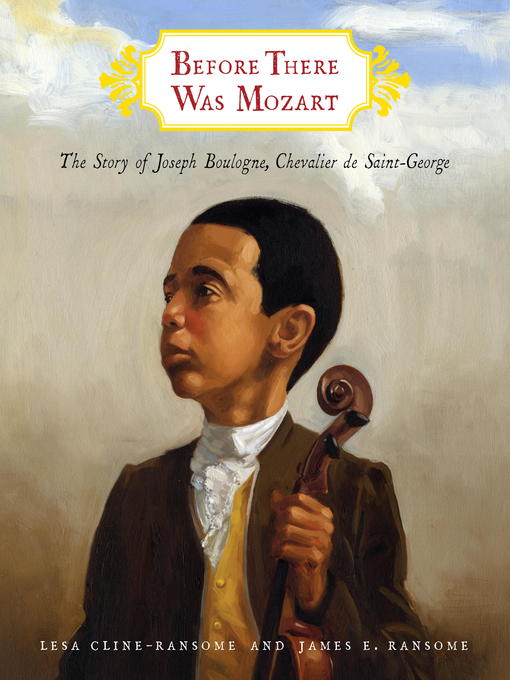
Before There Was Mozart
The Story of Joseph Boulogne, Chevalier de Saint-George
فرمت کتاب
ebook
تاریخ انتشار
2012
Lexile Score
1110
Reading Level
5
ATOS
6.3
Interest Level
K-3(LG)
نویسنده
James E. Ransomeشابک
9780307982490
کتاب های مرتبط
- اطلاعات
- نقد و بررسی
- دیدگاه کاربران
نقد و بررسی

December 20, 2010
Born in Guadeloupe, Joseph Boulogne was the son of a black slave and a white plantation owner of French nobility. When Joseph's family moved to France, he enrolled in school and, despite facing racial prejudice, devoted himself to mastering the violin, which he first learned to play on the plantation. In his lifetime, Joseph composed six operas (as well as other pieces of music), stood before audiences on the same stages as Mozart, and performed before Louis XVI and Marie Antoinette. Ransome's mixed-media paintings join tropical motifs with the sumptuous colors and prints of affluent Paris society, and his faces glow with vitality. Readers will likely marvel at why such a compelling figure has not received more attention. Ages 5–9.

December 15, 2010
In the spirit of their earlier collaboration (Young Pele: Soccer's First Star, 2007) the husband-and-wife team introduce readers to the life of a relative unknown: Joseph Boulogne, often known as "the Black Mozart." Boulonge was born on a plantation in the West Indies, the son of a Frenchman and a young Senegalese slave. Joseph was acknowledged and raised by both his parents, and his father encouraged his musical education in the Caribbean and Paris, where he became a darling of the French nobility. Despite the overt racism of pre-revolutionary France, he triumphed by dint of dedication and prodigious talent. James Ransome's rich, brushy strokes of vivid color expand the engaging text even as they evoke both the lush landscapes of the Caribbean and glittering candlelit interiors. The book's title is a bit of a puzzle. How many picture-book readers are familiar enough with the life of Wolfgang Amadeus Mozart to grasp that the life and impressive career of this Afro-Caribbean-French musical prodigy actually began before the sensation from Salzburg? That quibble notwithstanding, this is a story that needed to be told. (Picture book/biography. 5-9)
(COPYRIGHT (2010) KIRKUS REVIEWS/NIELSEN BUSINESS MEDIA, INC. ALL RIGHTS RESERVED.)

February 1, 2011
Gr 3-5-Saint-George was a contemporary of Mozart, and though the two apparently never met, they did perform on alternating evenings at the same Paris concert hall. In elegant prose and handsome paintings, the book recounts the rise to European fame of a talented boy from the West Indies. A short opening "movement" tells of Boulogne's birth to his slave mother on his French father's Guadalupe plantation. "Nanon closed her eyes in a prayer of thanks as she heard the midwife predict, 'One day this boy will meet the king and queen of France.'" "The "Second Movement" describes the fine education given the bright boy, the lively shipping port near the plantation, and the family's departure for France when Joseph was nine. His arrival in Paris and growth into a musical protege make up the longest of the three movements, and the "Finale" fulfills the midwife's prediction as Joseph plays at Versailles for Louis XVI and Marie Antoinette. Cline-Ransome summarizes the remaining 25 years of the chevalier's life in an afterword. Though the text describes Saint-George's work as violinist, conductor, and composer along with a recent honor accorded him in Paris, there's no mention of where readers might find information about him or hear his works. The colorful views of island life and of Europe provide a fine sense of the historical milieu, and the author reminds readers that though "not everyone was pleased to see a man of color, freshly powdered and bewigged, conducting a group of white musicians, all had to admit that his talents were magnifique." Saint-George's impressive accomplishments expand our understanding of music and human history, and librarians and teachers will find varied ways to introduce him to children.-Margaret Bush, Simmons College, Boston
Copyright 2011 School Library Journal, LLC Used with permission.

February 15, 2011
Grades 1-3 Growing up in the early-eighteenth century as the privileged only child of a household slave and her plantation owner on a tiny West Indian island, Joseph Boulogne heard music from around the globe, and he learned to play violin. After his father took him and his mother to Paris, Boulogne lived free, although he still suffered discrimination as a mulatto. As he grew up, he became a gifted, feted student who was taught by two great masters and given a beautiful instrument before he played first violin with a Paris orchestra and eventually became its conductor. By 30, he was a star, the first musician of color to play for royalty and a renowned composer. An authors note fills in more facts, but unfortunately, there are no sources included in this picture-book biography about a figure rarely featured in books for youth. The full-page, richly colored paintings give a strong sense of the changing settings, from plantation to palace, but most moving are the close-ups of the extraordinary musician with his fingers on the violin strings.(Reprinted with permission of Booklist, copyright 2011, American Library Association.)

























دیدگاه کاربران